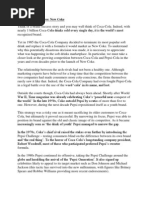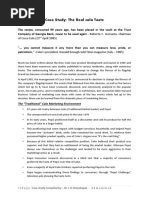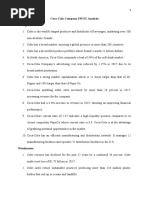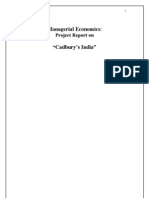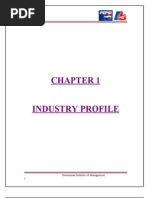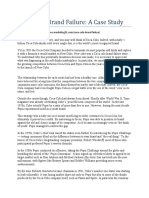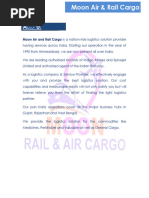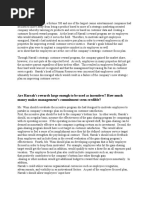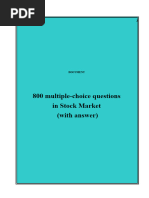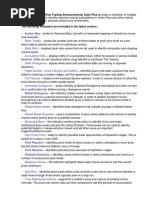New Coke: A Classic Brand Failure: Ellie Kennedy, Handout: Coke Case Study SWIT, 13/09/11
New Coke: A Classic Brand Failure: Ellie Kennedy, Handout: Coke Case Study SWIT, 13/09/11
Uploaded by
Roshni RajCopyright:
Available Formats
New Coke: A Classic Brand Failure: Ellie Kennedy, Handout: Coke Case Study SWIT, 13/09/11
New Coke: A Classic Brand Failure: Ellie Kennedy, Handout: Coke Case Study SWIT, 13/09/11
Uploaded by
Roshni RajOriginal Description:
Original Title
Copyright
Available Formats
Share this document
Did you find this document useful?
Is this content inappropriate?
Copyright:
Available Formats
New Coke: A Classic Brand Failure: Ellie Kennedy, Handout: Coke Case Study SWIT, 13/09/11
New Coke: A Classic Brand Failure: Ellie Kennedy, Handout: Coke Case Study SWIT, 13/09/11
Uploaded by
Roshni RajCopyright:
Available Formats
Ellie Kennedy, Handout: Coke Case Study
SWIT, 13/09/11
New Coke: A Classic Brand Failure
Think of a brand success story, and you may well think of Coca-Cola. Indeed, with nearly 1 billion Coca-Cola drinks sold every single day, it is the worlds most recognized brand. Yet in 1985 the Coca-Cola Company decided to terminate its most popular soft drink and replace it with a formula it would market as New Coke. To understand why this potentially disastrous decision was made, it is necessary to appreciate what was happening in the soft drinks marketplace. In particular, we must take a closer look at the growing competition between Coca-Cola and Pepsi-Cola in the years and even decades prior to the launch of New Coke. The relationship between the arch-rivals had not been a healthy one. Although marketing experts have believed for a long time that the competition between the two companies had made consumers more cola-conscious, the firms themselves rarely saw it like that. Indeed, the Coca-Cola Company had even fought Pepsi-Cola in a legal battle over the use of the word cola in its name, and lost. Outside the courts though, Coca-Cola had always been ahead. Shortly after World War II, Time magazine was already celebrating Cokes peaceful nearconquest of the world. In the late 1950s, Coke outsold Pepsi by a ratio of more than five to one. However, during the next decade Pepsi repositioned itself as a youth brand. This strategy was a risky one as it meant sacrificing its older customers to Coca-Cola, but ultimately it proved successful. By narrowing its focus, Pepsi was able to position its brand against the old and classic image of its competitor. As it became increasingly seen as the drink of youth Pepsi managed to narrow the gap. In the 1970s, Cokes chief rival raised the stakes even further by introducing the Pepsi Challenge testing consumers blind on the difference between its own brand and the real thing. To the horror of Coca-Colas longstanding company president, Robert Woodruff, most of those who participated preferred Pepsis sweeter formula. In the 1980s Pepsi continued its offensive, taking the Pepsi Challenge around the globe and heralding the arrival of the Pepsi Generation. It also signed up celebrities likely to appeal to its target market such as Don Johnson and Michael Jackson (this tactic has survived into the new millennium, with figures like Britney Spears and Robbie Williams providing more recent endorsements). By the time Roberto Goizueta became chairman in 1981, Cokes number one status was starting to look vulnerable. It was losing market share not only to Pepsi but also to some of the drinks produced by the CocaCola company itself, such as Fanta and Sprite. In particular the runaway success of Diet Coke was a double-edged sword, as it helped to shrink the sugar cola market. In 1983, the year Diet Coke moved into the number three position behind standard Coke and Pepsi, Cokes market share had slipped to an all-time low of just under 24 per cent. Something clearly had to be done to secure Cokes supremacy. Goizuetas first respon se to the Pepsi Challenge phenomenon was to launch an advertising campaign in 1984, praising Coke for being less sweet than Pepsi. The television ads were fronted by Bill Cosby, at that time one of the most familiar faces on the planet, and clearly someone who was too old to be part of the Pepsi Generation. The impact of such efforts to set Coca-Cola apart from its rival was limited. Cokes share of the market remained the same while Pepsi was catching up. Another worry was that when shoppers had the choice, such as in their local supermarket, they tended to plump for Pepsi. It was only Cokes more effective distribution which kept it ahead. For instance, there were still considerably more vending machines selling Coke than Pepsi. Even so, there was no getting away from the fact that despite the
Ellie Kennedy, Handout: Coke Case Study
SWIT, 13/09/11
proliferation of soft drink brands, Pepsi was winning new customers. Having already lost on taste, the last thing Coca-Cola could afford was to lose its number one status. The problem, as Coca-Cola perceived it, came down to the product itself. As the Pepsi Challenge had highlighted millions of times over, Coke could always be defeated when it came down to taste. This seemed to be confirmed by the success of Diet Coke which was closer to Pepsi in terms of flavour. So in what must have been seen as a logical step, CocaCola started working on a new formula. A year later they had arrived at New Coke. Having produced its new formula, the Atlanta-based company conducted 200,000 taste tests to see how it fared. The results were overwhelming. Not only did it taste better than the original, but people preferred it to Pepsi-Cola as well. However, if Coca-Cola was to stay ahead of Pepsi-Cola it couldnt have two directly competing products on the shelves at the same time. It therefore decided to scrap the original Coca-Cola and introduced New Coke in its place. The trouble was that the Coca-Cola company had severely underestimated the power of its first brand. As soon as the decision was announced, a large percentage of the US population immediately decided to boycott the new product. On 23 April 1985 New Coke was introduced and a few days later the production of original Coke was stopped. This joint decision has since been referred to as the biggest marketing blunder of all time. Sales of New Coke were low and public outrage was high at the fact that the original was no longer available. It soon became clear that Coca-Cola had little choice but to bring back its original brand and formula. We have heard you, said Goizueta at a press conference on 11 July 1985. He then left it to the companys chief operating officer Donald Keough to announce the return of the product. Keough admitted: The simple fact is that all the time and money and skill poured into consumer research on the new Coca-Cola could not measure or reveal the deep and abiding emotional attachment to original Coca-Cola felt by so many people. The passion for original Coca-Cola and that is the word for it, passion was something that caught us by surprise. It is a wonderful American mystery, a lovely American enigma, and you cannot measure it any more than you can measure love, pride or patriotism. In other words, Coca-Cola had learnt that marketing is about much more than the product itself. The majority of the tests had been carried out blind, and therefore taste was the only factor under assessment. The company had finally taken Pepsis bait and, in doing so, conceded its key brand asset: originality. When Coca-Cola was launched in the 1880s it was the only product in the market. As such, it invented a new category and the brand name became the name of the product itself. Throughout most of the last century, Coca- Cola capitalized on its original status in various advertising campaigns. In 1942, magazine adverts appeared across the United States declaring: The only thing like Coca-Cola is Coca-Cola itself. Its the real thing. By launching New Coke, Coca-Cola was therefore contradicting its previous marketing efforts. Its central product hadnt been called new since the very first advert appeared in the Atlanta Journal in 1886, billing Coca- Cola as The New Pop Soda Fountain Drink, containing the properties of the wonderful Coca-plant and the famous Cola nuts. In 1985, a century after the product launched, the last word people associated with Coca-Cola was new. This was the company
Ellie Kennedy, Handout: Coke Case Study
SWIT, 13/09/11
with more allusions to US heritage than any other. Fifty years previously, the Pulitzer Prize winning editor of a Kansas newspaper, William Allen White had referred to the soft drink as the sublimated essence of all America stands for a decent thing, honestly made, universally distributed, and conscientiously improved with the years. Coca-Cola had even been involved with the history of US space travel, famously greeting Apollo astronauts with a sign reading Welcome back to earth, home of Coca-Cola. To confine the brands significance to a question of taste was therefore completely misguided. As with many big brands, the representation was more significant than the thing represented, and if any soft drink represented new it was Pepsi, not Coca-Cola (even though Pepsi is a mere decade younger). If you tell the world you have the real thing you cannot then come up with a new real thing. To borrow the comparison of marketing guru Al Ries its like introducing a New God. This contradictory marketing message was accentuated by the fact that, since 1982, Cokes strap line had been Coke is it. Now it was telling consumers that they had got it wrong, as if they had discovered Coke wasnt it, but rather New Coke was instead. So despite the tremendous amount of hype which surrounded the launch of New Coke (one estimate puts the value of New Cokes free publicity at over US $10 million), it was destined to fail. Although Coca-Colas market researchers knew enough about branding to understand that consumers would go with their brand preference if the taste tests werent blind, they failed to make the connection that these brand preferences would still exist once the product was launched. Pepsi was, perhaps unsurprisingly, the first to recognize Coca-Colas mistake. Within weeks of the launch, it ran a TV ad with an old man sitting on a park bench, staring at the can in his hand. They changed my Coke, he said, clearly distressed. I cant believe it. However, when Coca-Cola relaunched its original coke, redubbed Classic Coke for the US market, the media interest swung back in the brands favour. It was considered a significant enough event to warrant a newsflash on ABC News and other US networks. Within months Coke had returned to the number one spot and New Coke had all but faded away. Ironically, through the brand failure of New Coke loyalty to the real thing intensified. In fact, certain conspiracy theorists have even gone so far as to say the whole thing had been planned as a deliberate marketing ploy to reaffirm public affection for Coca-Cola. After all, what better way to make someone appreciate the value of your global brand than to withdraw it completely? Of course, Coca-Cola has denied that this was the companys intention. Some critics will say Coca-Cola made a marketing mistake, some cynics will say that we planned the whole thing, said Donald Keough at the time. The truth is we are not that dumb, and we are not that smart. But viewed in the context of its competition with Pepsi, the decision to launch New Coke was understandable. For years, Pepsis key weapon had been the taste of its product. By launching New Coke, the Coca-Cola Company clearly hoped to weaken its main rivals marketing offensive. So what was Pepsis verdict on the whole episode? In his book, The Other Guy Blinked, Pepsis CEO Roger Enrico believes the error of New Coke proved to be a valuable lesson for Coca-Cola. I think, by the end of their nightmare, they figured out who they really are. Caretakers. They cant change the taste of their flagship brand. They cant change its imagery. All they can do is defend the heritage they nearly abandoned in 1985.
Ellie Kennedy, Handout: Coke Case Study
SWIT, 13/09/11
Case Study New Coke: A Classic Brand Failure
Original lesson plan: Tutor reads 3-page case study aloud to class Students use case study to write answers to the following questions 1. The launch of New Coke turned out to be a nightmare for CocaCola. Discuss the marketing implications of introducing New Coke. 2. Was it necessary to re-formulate New Coke? 3. Where did market research fail in this case? What would you do if you were a market researcher? Whole-class debate on was new Coke a tactical manoeuvre or a mistake?
Brainstorm: How would you approach this case study to enable international students to engage with this material and its key issues about marketing failure?
You might also like
- Flipping Markets: Trading Plan 2.0.1Document60 pagesFlipping Markets: Trading Plan 2.0.1Lentera95% (20)
- Marketing On Instagram Social Influence and Image Quality On Perception of Quality and Purchase IntentionDocument13 pagesMarketing On Instagram Social Influence and Image Quality On Perception of Quality and Purchase IntentionPutri AwaliaNo ratings yet
- What Were Some of The Limitations of The Research Process That Compromised The Validity and The Reliability of Coke's Research Process?Document2 pagesWhat Were Some of The Limitations of The Research Process That Compromised The Validity and The Reliability of Coke's Research Process?Mukesh KumarNo ratings yet
- Sample Report 1 - 7up PopDocument40 pagesSample Report 1 - 7up Popapi-3739324100% (1)
- MARKETING STRATEGIES Pepsi NoidaDocument80 pagesMARKETING STRATEGIES Pepsi NoidaSami ZamaNo ratings yet
- Brand FailureDocument6 pagesBrand FailureHarish KeshwaniNo ratings yet
- Classic Brand Failures - CocacolaDocument5 pagesClassic Brand Failures - CocacolaumairjunejoNo ratings yet
- Coca Cola Brand RepositioningDocument11 pagesCoca Cola Brand RepositioningrajatNo ratings yet
- The Launch of New CokeDocument14 pagesThe Launch of New CokeVishal VaidNo ratings yet
- New Coke Case StudyDocument5 pagesNew Coke Case Studytejas parmarNo ratings yet
- Coco Cola BCDocument31 pagesCoco Cola BCnandini swamiNo ratings yet
- Chinese Dumping With CasestudiesDocument32 pagesChinese Dumping With CasestudiesJinal ShahNo ratings yet
- MGMC01 Introducing New CokeDocument11 pagesMGMC01 Introducing New Cokenavafaria03No ratings yet
- Financial Analysis of Coca-Cola: Financial Successes and FailuresDocument3 pagesFinancial Analysis of Coca-Cola: Financial Successes and FailuresStefan Hehe100% (1)
- Brand Audit ReportDocument30 pagesBrand Audit ReportSuman TripathyNo ratings yet
- Dokumen - Tips Brand Audit of NestleDocument44 pagesDokumen - Tips Brand Audit of NestleGaurav PantNo ratings yet
- Report On Distribution Effectiveness of Cola, IndiaDocument57 pagesReport On Distribution Effectiveness of Cola, Indiamonish_shah28100% (1)
- Coca Cola Rural Marketing Case StudyDocument23 pagesCoca Cola Rural Marketing Case StudyKirity Kumar100% (1)
- Pestel Analysis of Coca ColaDocument4 pagesPestel Analysis of Coca Colatejaskamble450% (1)
- Coca Cola SWOT AnalysisDocument4 pagesCoca Cola SWOT AnalysisDavidNo ratings yet
- Managerial Economics: Cadbury's India": Project Report On "Document19 pagesManagerial Economics: Cadbury's India": Project Report On "arjbaidNo ratings yet
- Coca Cola (Consumer Buying Behaviour)Document84 pagesCoca Cola (Consumer Buying Behaviour)Ravi Kant Verma100% (4)
- Coca ColaDocument18 pagesCoca ColajigneshvamjaNo ratings yet
- A Summer Internship PROJECT REPORT On Coca Cola11Document29 pagesA Summer Internship PROJECT REPORT On Coca Cola11Deep Bajwa100% (1)
- Cadbury ArticleDocument30 pagesCadbury ArticleBoaz Eapen100% (1)
- Group No. 2: Introducing New CokeDocument10 pagesGroup No. 2: Introducing New CokeAbhishekSinghNo ratings yet
- Project Report by Sarthak Pandyaa BBA 4BDocument83 pagesProject Report by Sarthak Pandyaa BBA 4BSUMIT KUMAR PANDEY P100% (2)
- Project: "Study of Consumer Preference Towards Cadbury and Nestle Chocolates"Document75 pagesProject: "Study of Consumer Preference Towards Cadbury and Nestle Chocolates"altaf_ahmadNo ratings yet
- Porter's Five Forces in Action: Sample Analysis of Coca-ColaDocument11 pagesPorter's Five Forces in Action: Sample Analysis of Coca-ColaImran KhanNo ratings yet
- Study of Consumer Prefarence Towards Cadbury and Nestle ChocolateDocument52 pagesStudy of Consumer Prefarence Towards Cadbury and Nestle ChocolatemanuNo ratings yet
- Comparative Study of Thums Up and PepsiDocument84 pagesComparative Study of Thums Up and Pepsipragya_pandey_4100% (1)
- MAMADocument8 pagesMAMAMister aabidNo ratings yet
- MGMC01 Case Analysis Boston Fights DrugsDocument9 pagesMGMC01 Case Analysis Boston Fights Drugsnavafaria03No ratings yet
- Coca Cola Consumer BehaviorDocument11 pagesCoca Cola Consumer BehaviorPriyanka RajanalaNo ratings yet
- Target MarketDocument6 pagesTarget MarketAbdul RehmanNo ratings yet
- Pepsi Miniproject8Document68 pagesPepsi Miniproject8sudhakar5472No ratings yet
- Pepsico India Uk Abhinav Gupta FinalDocument19 pagesPepsico India Uk Abhinav Gupta FinalAbhinav Gupta100% (1)
- Coca ColaDocument8 pagesCoca ColaShaad AlviNo ratings yet
- A Study of Maggi Brand Repositioning and ExtensionDocument17 pagesA Study of Maggi Brand Repositioning and ExtensionAman KaushalNo ratings yet
- MM2 Project Group 3Document29 pagesMM2 Project Group 3Sree RamNo ratings yet
- Research Project Report ON Marketing Strategy of Amul Submitted ToDocument80 pagesResearch Project Report ON Marketing Strategy of Amul Submitted Tokushagra JainNo ratings yet
- PepsiCo Live ProjectDocument134 pagesPepsiCo Live ProjectPrateek Singh Parihar100% (1)
- Final Project: NAME: - Sujith Suresh UID: - 2019-2105-0001-0007 UnileverDocument38 pagesFinal Project: NAME: - Sujith Suresh UID: - 2019-2105-0001-0007 UnileverSujith SureshNo ratings yet
- ADVERTISING PROJECT Group 9Document11 pagesADVERTISING PROJECT Group 9Siddharth Singh Tomar0% (1)
- PepsicoDocument71 pagesPepsicoMulayam KhanguraNo ratings yet
- Summary On Brand Audit of PepsiDocument75 pagesSummary On Brand Audit of Pepsimohitsm100% (1)
- Diet CokeDocument19 pagesDiet CokeMc ThitiNo ratings yet
- Bba 3rd Year ProjectDocument56 pagesBba 3rd Year ProjectManash GopeNo ratings yet
- Porter's Five Forces Analysis of The Coca Cola CompanyDocument2 pagesPorter's Five Forces Analysis of The Coca Cola Companytaskeen rizviNo ratings yet
- NindiyaDocument26 pagesNindiyaPooja LangrooNo ratings yet
- Marketing Plan For GatoradeDocument13 pagesMarketing Plan For GatoradeBu TuNo ratings yet
- Soft Drink Industry AnalysisDocument3 pagesSoft Drink Industry AnalysisNaseer Ahmad AziziNo ratings yet
- AcknowledgementDocument6 pagesAcknowledgementMaria JavedNo ratings yet
- KFC Advertising ProjectDocument6 pagesKFC Advertising ProjectzoukuNo ratings yet
- Marketing Project Report: Submitted By: - Group 6Document12 pagesMarketing Project Report: Submitted By: - Group 6DeepNo ratings yet
- Project On IPO of Cafe Coffee DayDocument45 pagesProject On IPO of Cafe Coffee DayVinit Dawane100% (1)
- Red and Green Process at Coca Cola Impact OnDocument95 pagesRed and Green Process at Coca Cola Impact OnAnimesh TiwariNo ratings yet
- Final Report On Positioning On Chocolate BrandDocument32 pagesFinal Report On Positioning On Chocolate BrandMoin KhanNo ratings yet
- Green Products A Complete Guide - 2020 EditionFrom EverandGreen Products A Complete Guide - 2020 EditionRating: 5 out of 5 stars5/5 (1)
- Coca Cola Brand Failure - Case StudyDocument5 pagesCoca Cola Brand Failure - Case StudyKabeer QureshiNo ratings yet
- Classic Failure CokeDocument4 pagesClassic Failure CokecpprriiyyaaNo ratings yet
- New Coke - Wrong Prob IdentfnDocument4 pagesNew Coke - Wrong Prob Identfnparam.shah21No ratings yet
- Rafia Bibi GBS Unit 40 IMDocument43 pagesRafia Bibi GBS Unit 40 IMLucifer 3013No ratings yet
- G CAP BrochureDocument1 pageG CAP BrochureParker ShahNo ratings yet
- Strategic Financial Management AssignmentDocument7 pagesStrategic Financial Management AssignmentdhanyamelamNo ratings yet
- Ssi AlmanacDocument2 pagesSsi Almanaceben.hammond11No ratings yet
- Business Owners List Fabrication and OthersDocument112 pagesBusiness Owners List Fabrication and OthersgreatfargoNo ratings yet
- 1834 Hotels-WPS OfficeDocument9 pages1834 Hotels-WPS OfficebashiratNo ratings yet
- 11th Accountancy EM FULL BOOkDocument352 pages11th Accountancy EM FULL BOOkBasker GopalakrishnanNo ratings yet
- Day 25 Passage 2Document5 pagesDay 25 Passage 2deamirxonokenNo ratings yet
- (Dsiopma) k36 Reala Reflection PaperDocument2 pages(Dsiopma) k36 Reala Reflection PaperElijah RealaNo ratings yet
- 15.annexue2 - Process Sequence & InteractionDocument4 pages15.annexue2 - Process Sequence & Interactioncer.qualityNo ratings yet
- Moon Profile CompleteDocument4 pagesMoon Profile CompletefarkisaraspurNo ratings yet
- Session 8Document12 pagesSession 8Adil AnwarNo ratings yet
- Harrah'sDocument3 pagesHarrah'sPiyush SahaNo ratings yet
- Bignay v. Union Bank of The PhilippinesDocument1 pageBignay v. Union Bank of The PhilippinesAdrian KitNo ratings yet
- 800 Cau TTCKDocument73 pages800 Cau TTCKkimphuc3819No ratings yet
- Marketing and Communication Strategy: Student Name Instructor Institution Affiliation Course Name Due DateDocument13 pagesMarketing and Communication Strategy: Student Name Instructor Institution Affiliation Course Name Due Datemoses gichanaNo ratings yet
- GST & Custom Duty - 18233364 - 2024 - 01 - 23 - 08 - 53Document440 pagesGST & Custom Duty - 18233364 - 2024 - 01 - 23 - 08 - 53Yasu RawteNo ratings yet
- Soal UTS English 2Document2 pagesSoal UTS English 2akunpraktek43No ratings yet
- The Effects of Social Media Marketing On Online Consumer Behavior by Simona Vinerean, Iuliana Cetina, Luigi Dumitrescu & Mihai TichindeleanDocument15 pagesThe Effects of Social Media Marketing On Online Consumer Behavior by Simona Vinerean, Iuliana Cetina, Luigi Dumitrescu & Mihai TichindeleanLisaNo ratings yet
- Uge2 1Document15 pagesUge2 1Francis OrtizNo ratings yet
- 2018 SalaryDocument2 pages2018 SalaryJames LaiNo ratings yet
- The Implementation and Adopting of Activity Based Costing in Manufacturing Vietnamese Companies A Case Study of Samsung Vina CorporationDocument37 pagesThe Implementation and Adopting of Activity Based Costing in Manufacturing Vietnamese Companies A Case Study of Samsung Vina CorporationTieu Ngoc LyNo ratings yet
- Rajesh Exports Ltd.Document18 pagesRajesh Exports Ltd.Prisha BhatiNo ratings yet
- Sayma Nasrin: StudentDocument2 pagesSayma Nasrin: StudentSayma NasrinNo ratings yet
- Social Media Marketing Strategies For Increasing Customer EngagemDocument148 pagesSocial Media Marketing Strategies For Increasing Customer EngagemSabee ShakeelNo ratings yet
- TG #02 - ABM 006Document7 pagesTG #02 - ABM 006Cyrill Paghangaan VitorNo ratings yet
- Often Suite Indicators For NinjaDocument2 pagesOften Suite Indicators For NinjaStock TradingNo ratings yet
- Finance 13e CH02 PPTDocument28 pagesFinance 13e CH02 PPTJOANNA LAMNo ratings yet






